
^^ “Writers’ block is REAL. It’s the same for books as it is for emails. Having a plan and a replicable process means you don’t let it win.
Writers’ block is a real thing. It’s the same for “writing an email” as it is for “writing a book”. If you have no starting point, no central idea for what you’re going to put down on paper… things get messy.
Luckily, writers’ block is an avoidable affliction.
“Ever wonder how some authors can crank out 6 (or more) novels a year, while you're sat staring at the BCOD (Blinking Cursor of Death)? They have a plan, an outline, a structure, and a scene list. That's how.”
It’s no kind of Voodoo or black magic.
It’s the same for writing effective emails. If you sit down with “no idea what to write”, you’re going to struggle. Luckily, “coming up with ideas” – for email content, books, whatever it might be – is something you can learn with the skills you already have.
Of course, we’re talking emails here. And the process of “coming up with ideas” is the same as for anything else.
“Where do I get my ideas from? I make them up. Out of my head... And when you've an idea - which is, after all, merely something to hold on to as you begin - what then? Well, then you write. You put one word after another until it's finished - whatever it is.”
So, how do you come up with an idea that *works* – and how do you “put one word after the other until it’s finished”?
Remember our heroes / heroines?
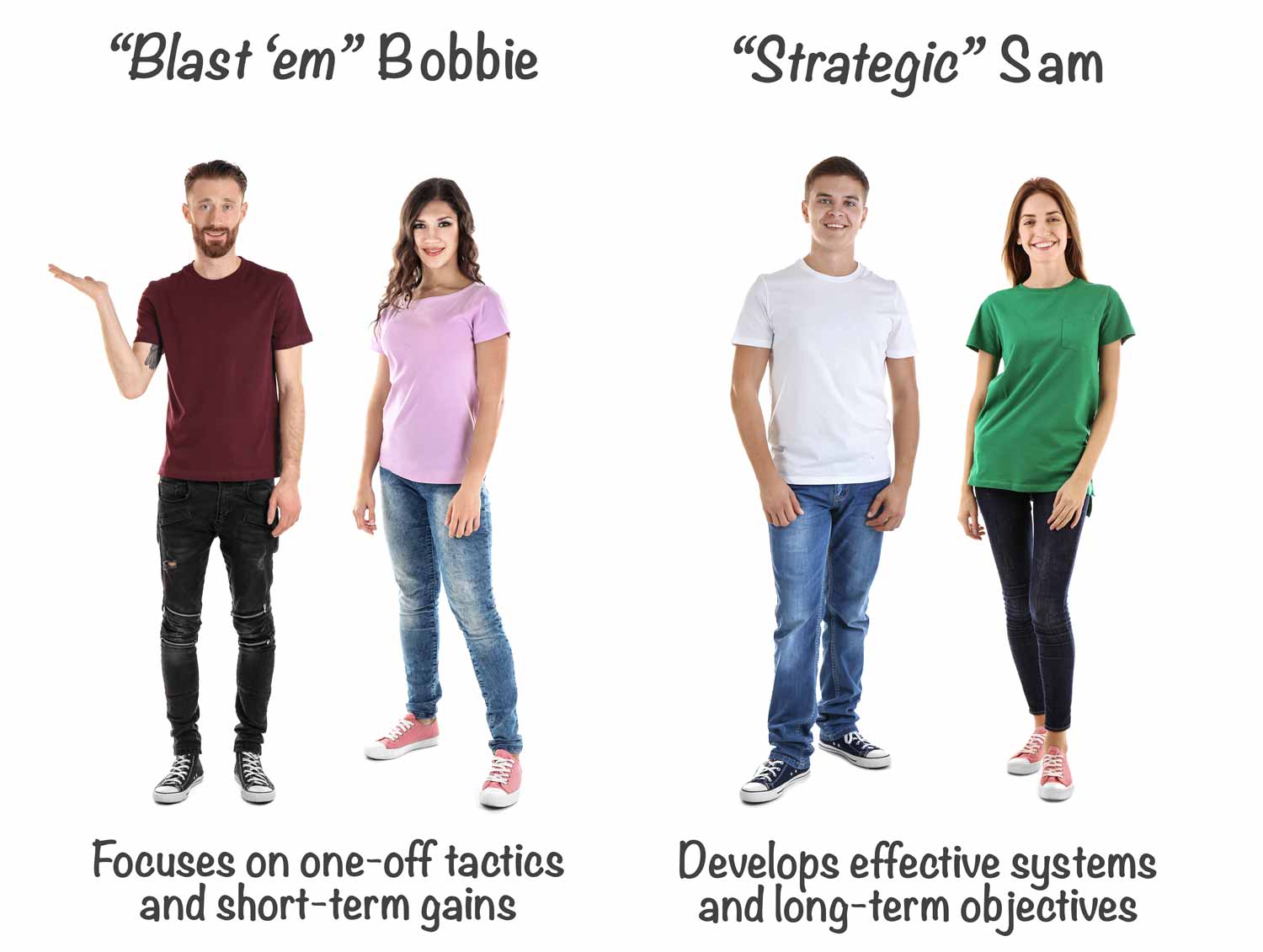
“Blast ’em Bobbie” sends out emails whenever there’s something to sell. The process is: “Talk about my book and how awesome it is, then tell people they should buy it”. Bobbie usually stares at a blank screen for 20 minutes, before rattling off some hyperbolic copy and stuffing in 17 “buy” links throughout. Bobbie feels like taking a shower afterwards.
“Strategic Sam” has a different approach. Instead of “sitting down and hoping for the best”, Sam spends five minutes plotting out the key details, actions, and responses required to meet the business objective. Then Sam spends 10 – 15 minutes writing the content and “filling in the gaps” with content designed to evoke an emotional response and provide value.
(You can probably guess which strategy works best. Both in terms of “how easy it is to do” and “getting the results you want”).
To move from a “Bobbie” to a “Sam” outcome, I want to share the second part of the “content puzzle” with you.
In the previous section, I introduced you to a structure – or “framework” – for writing an effective email. Namely:
With that all in place, it’s time to “slot in” you central idea. Around which all your copy will revolve.
We’ve hinted at “coming up with ideas” already – even if you’re a fiction author – and the actual idea itself, or “topic”, is something that gets easier to do the more you practice. Your idea could literally be anything. Something from your personal life. An event that’s happening in the news. Something from your books. What you’re working on. Something somebody said to you the other day… anything.
But, for starters, you idea needs to follow a few simple principles:
Here’s an example of one email I sent out leading up to this Email Marketing Unplugged (EMU) series, the first time I ever released it.
A note on the topic – you can get ideas literally from anywhere. For me, at the time, England had just won a penalty shoot-out for the first time in World Cup history and the whole country was going crazy over it… That was an easy topic to run with, but I had to make it relevant. Come see what I did (NB – I’ll give more examples in different genres / niches afterwards):
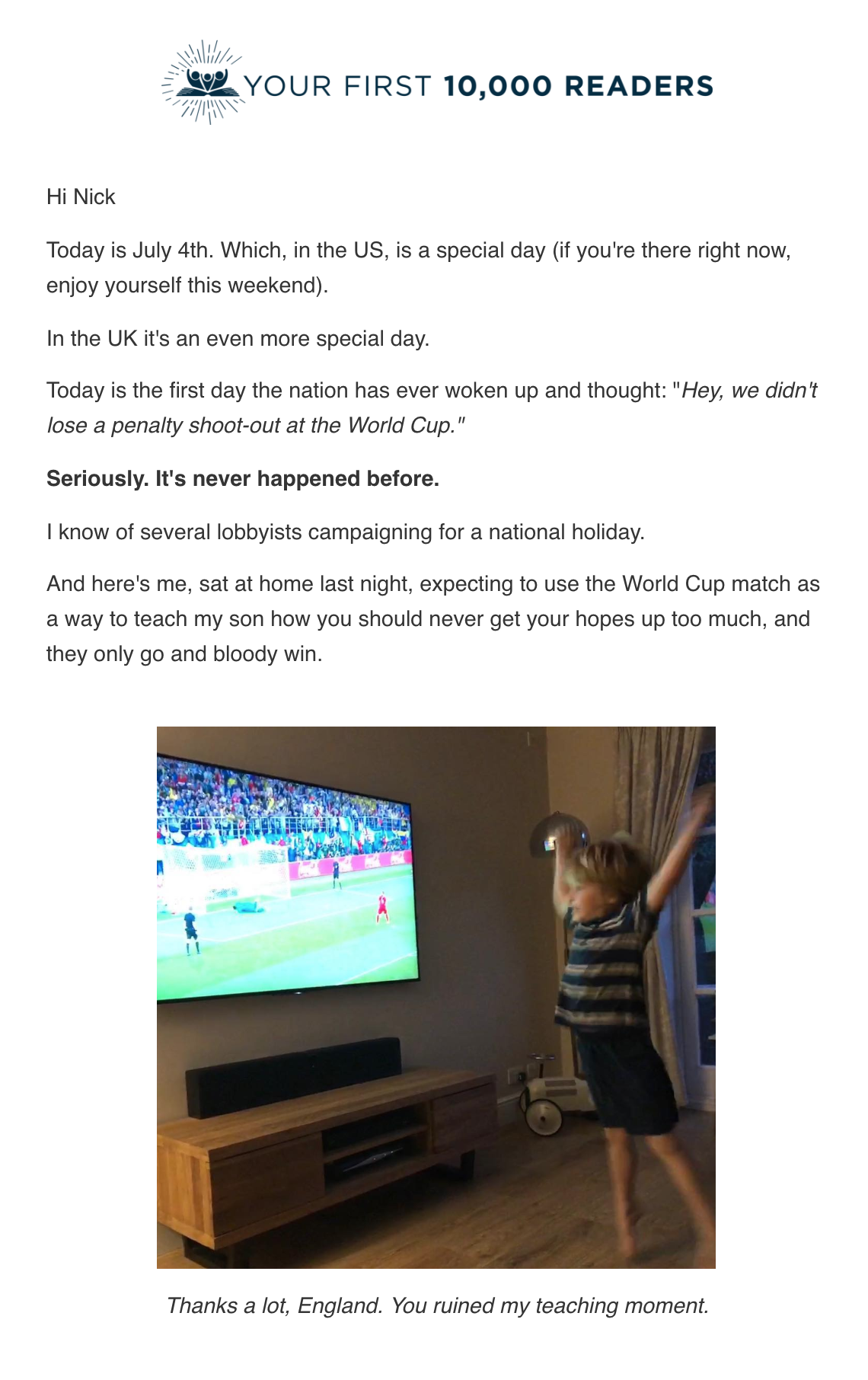
Remember what I said earlier about “inviting people into your world”? That’s what I’m doing here. A little dash of humour, a cute family pic, and some “interesting news”.
Which is fine – it gets people’s attention. Makes them feel “included” in what’s going on (which is the point). But it’s not relevant to a lot of people – yet. So we have to transition into something that is.
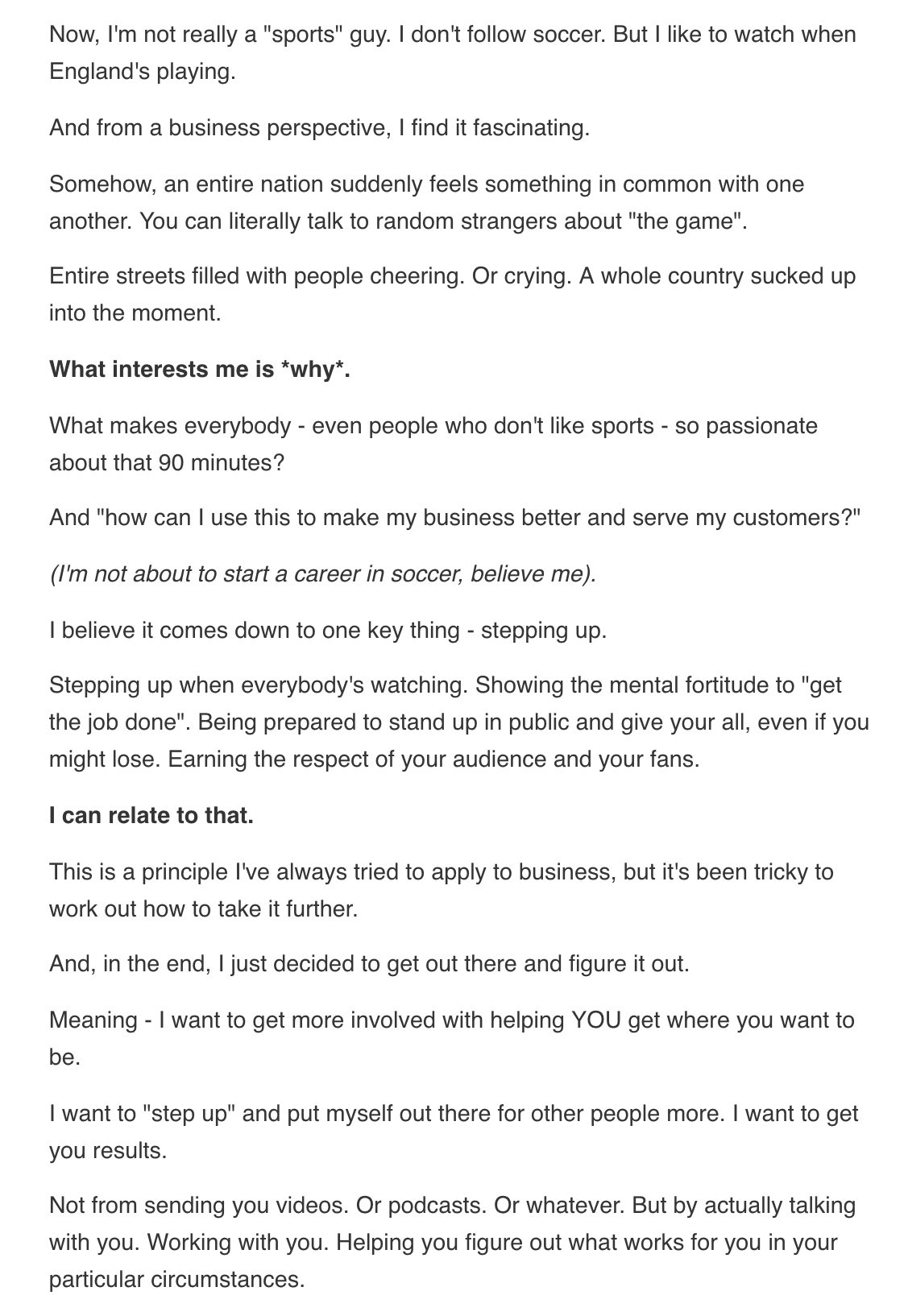
Here, I’m taking a general topic – eg “a soccer match” – and making it relevant to my audience. In particular, how business owners need to “step up” under pressure, just like the players in the game.
(Notice how “soccer” itself has nothing much to do with the subject of the email series – this is a key point, especially for fiction writers: you can take pretty much ANY TOPIC and transition into your books, or your main offer).
Okay, check. We got people’s attention with the opening section, and we’ve transitioned into “Interest”. People are thinking… “Okay, that makes sense. How is this going to affect me?”
We’ve transitioned into Interest – but now we need a dash of “desire” and “action”.
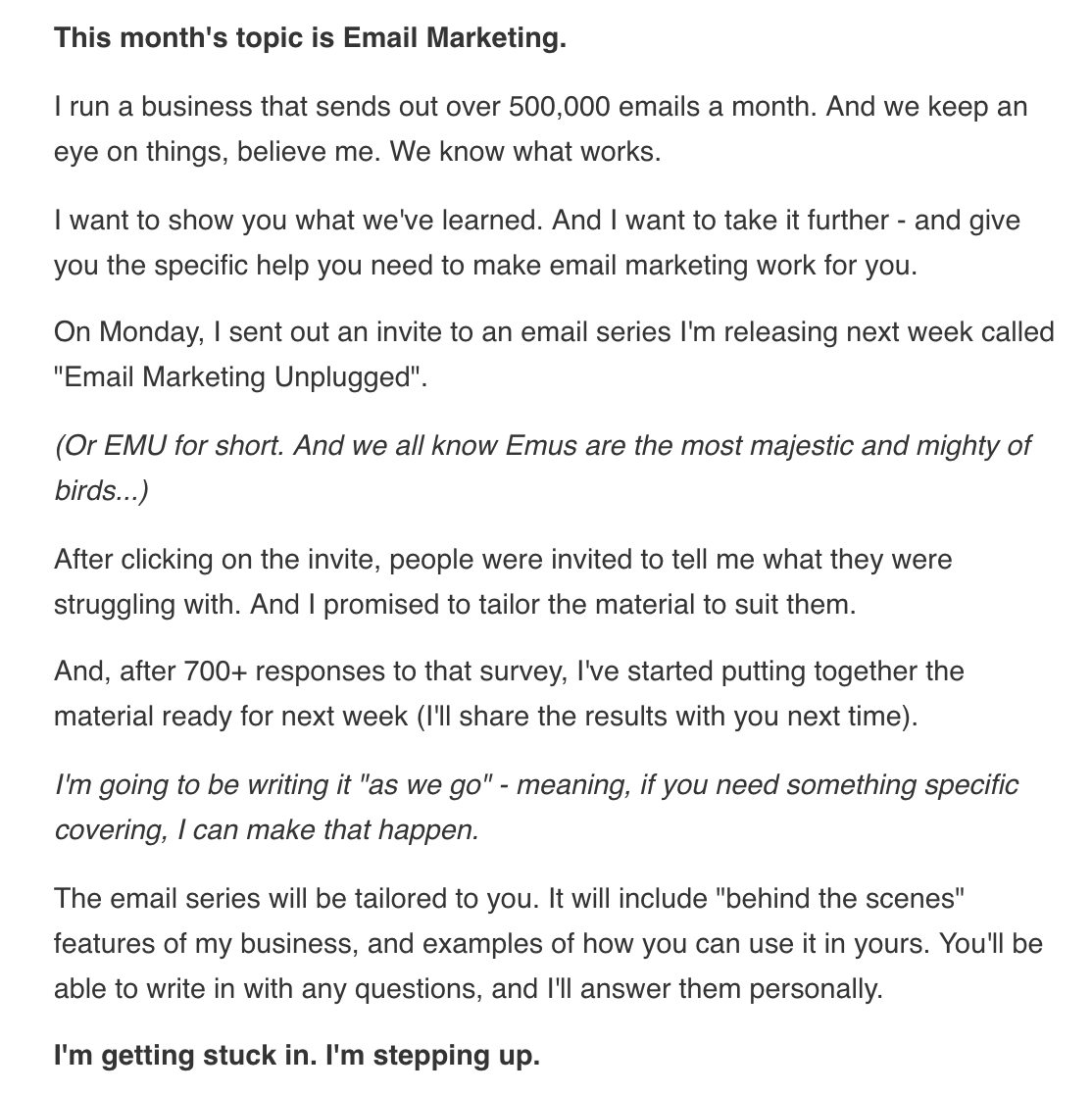
In this section, I’m taking what we’ve covered already – the need for business owners to “step up” and help more people – and I’m not segueing into “specifically what am I going to do about this and how will it help you”.
Notice I’m getting a little more specific here. I want my readers to feel that desire to get involved. Not with any fake scarcity play, or gimmicks, but with good old-fashioned “I’m going to put some work into helping you personally with your email marketing”.
Now it’s super-relevant to anyone who needs help with email marketing. We’ve gone from the general “idea” (soccer) to a general business principle (stepping up and helping) to a super specific OFFER (I’ll help you with email marketing in these specific ways).
At this point, anyone who’s interested in learning about email marketing is going to have boat-loads of Desire.
I’ve also added a dash of “proof” too – specifically “We send 500,000 emails a month, so we know what works”. You can’t create desire for something if people don’t believe you can deliver (more on that later, too).
(NB: notice this email is quite long. I like long emails. So many “experts” will tell you to “keep it short”, but longer emails automatically filter out the “not that interested” people by putting your links at the end of 1,000 words. But the other side of the coin is you have to work harder to get through AIDA every time to get the right people to read that far – otherwise people skim or give up)
We’ve earned attention. We’ve developed interest and desire (from the *right* people – more on that later) so now it’s time to move to the call to action:
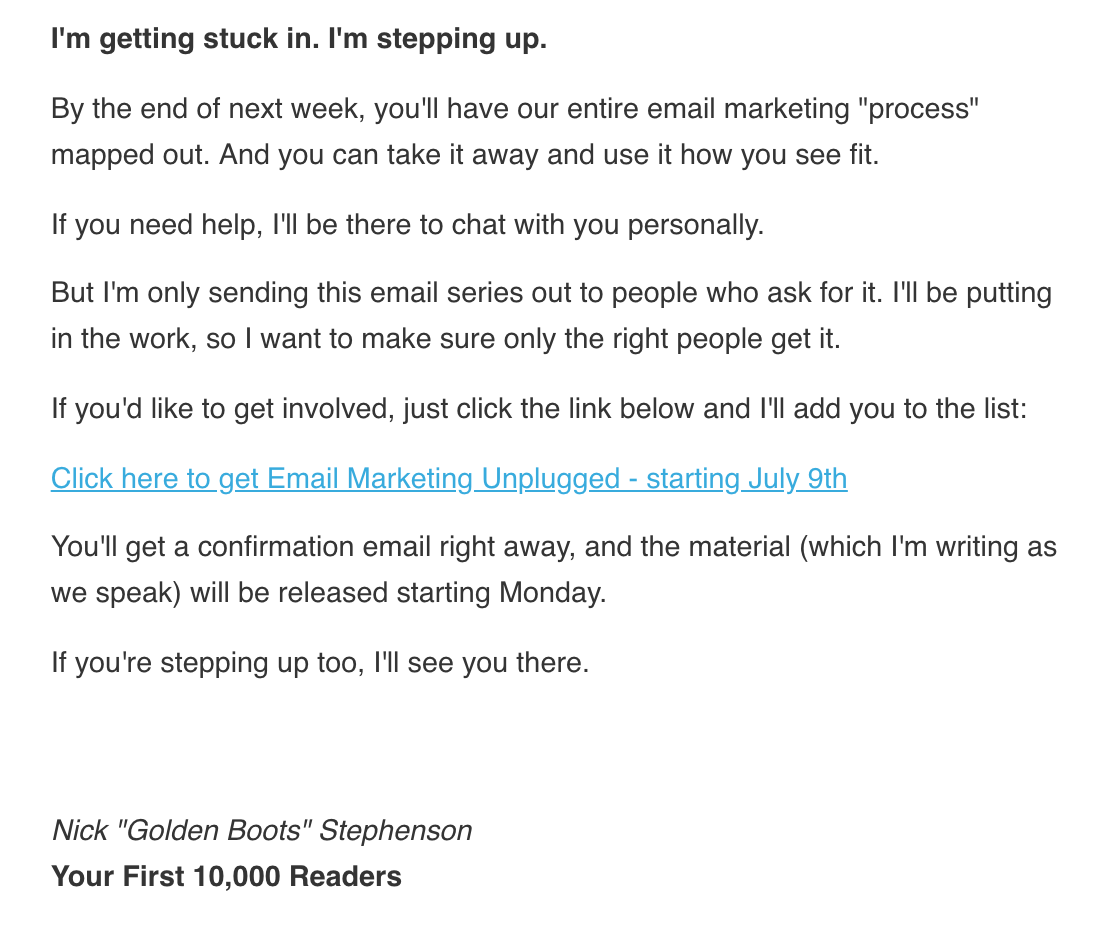
This is the easy part. Where before I was focusing on “Inspiration” as my tone, now I’ve shifted into “Information”. In other words, I’m getting super-specific about “what to do next”.
In this case, I want “people who are interested in learning about email marketing” to opt in to receive my EMU email series (which, of course, leads to this series of articles you’re reading now – meta, right?).
When readers click the link, my email system (Infusionsoft) tags them and automatically segments them into an “EMU sequence”. They then automatically get a welcome email with a few more details and will receive broadcasts about this EMU article series you’re reading now.
They are also invited to fill out a short survey to let me know more about their issues – so I can tailor the material to them (which is exactly what I’ve done – meta-tastic).
I’m sharing this particular email with you (and I’ll show you some other fiction and non-fiction examples in a minute) because it’s not the most amazing email ever.
In other words, in my own perfectionist opinion, it’s not the greatest thing I’ve ever written.
Which is an important point.
Your emails don’t have to be Pulitzer Prize winners every time. They just need to get results. And this one delivered in spades.
Between this email and the one I sent a couple of days before, we had 1,500 people opt in for our EMU series and received around 900 survey responses. By the end of the campaign we had 2,300 opted in and 1,300 responses – a 56% response rate.
(Those results might not mean anything to you in isolation, but they’re very good).
And this is a key reason why “open rates” and “click rates” aren’t as important – in isolation – as you think they are. At least, they’re not the key metric you should be worrying about – most of the time.
Case in point – the emails we sent out inviting people to EMU might have only had an unexciting click rate, but they drove 1,300 extremely valuable actions. That’s the key driver for success, and that’s what we look at the define whether it “worked” or not.
(You can then look at what you might be able to do to improve the number of responses by increasing open and click rates in the future, but the numbers themselves don’t mean anything without an action attached to them).
Instead of fixating on open rates, worry instead about “how many people are performing the action I need to meet my objective”. And in our case, that was = lots.
So, even a relatively hum-drum email (in my opinion anyway) can get you great results. Which is entirely the point of my showing you this.
Once you’ve got your objective, AIDA, tone, and idea – you’re ready to get going with your structure.
With your framework, your idea, and your structure – you’re ready to rock.
Now, I’ve shown you an example from my business – but what about fiction?
Like any other effective email, you’ll follow that process:
Bob writes thrillers, with a forensic science twist. He’s got a book coming out soon and wants to get some great ARC readers to read his book and give him a review on launch day. Here’s how Bob would approach that process:
Two objectives here – (1) get the “best” people to download an ARC copy of his book, and (2) ensure they’re primed to leave a review on launch day.
Bob has a few options. He could send out a few emails and cover different elements of AIDA in each one. Or, he can write one or two emails and cover all the elements. For the sake of brevity, let’s say he decides to write an email covering all of them.
Bob writes fiction, with a forensic twist. That means his readers are interested in thrillers and forensic science (duh). Bob decides to use a mix of entertainment and education – a little science behind the story.
Bob read in the newspaper that scientists have been studying one of the oldest complete human skeletons ever found – dubbed “Cheddar Man”. He learns that, using modern techniques, they’ve been able to identify that his skin was black and his eyes were blue.
Bob knows for anyone interested in forensic science, this is an interesting topic. And it’s something he can relate back to his books quite easily.
The process is the same, whatever genre you write.
Jane runs a Facebook consulting service and has written several books on paid advertising on that platform. She is launching a new book all about “Facebook Advertising for Etsy Shop Owners” and wants to get as many sales as possible on launch day.
Sell as many copies as possible in the first three days.
Again, Jane can separate this out or write one email covering all the elements. I always recommend the former option (and I’ll lay that process out for you on a later page) but for the sake of the demonstration, let’s say Jane doesn’t listen to me and only sends out one email covering all the elements…
Jane wants to sell a book about Facebook advertising, so she’ll use a mix of Education (showing off her expertise) and Inspiration (showing what results people might get and how it will improve their businesses).
Jane read that Facebook recently updated their algorithms and knows a lot of people are concerned about it. So Jane wants to dispel some myths and show how she can help.
See how this works? There’s a defined process for coming up with ideas, expanding those ideas, and crafting emails that take readers “on a journey” towards the action you want them to perform.
For more examples, check out this video – where I go through several authors’ emails and revise them to meet this process:
Update: Simone got in touch with a revised structure for her latest email – which is much tighter. Check out the difference here.
Whatever genre you write, whatever niche you serve, using this process takes all the “guesswork” out of writing effective emails.
To the point where ideas will come to you in droves – and you’ll never be stuck wondering “what to write”.
In fact, you can write an effective email in just 10 – 15 minutes if you spend 5 minutes working through this structure. Here’s an example (taken from one of the emails I sent to you):
^^ Note: having started writing out the email I planned in the above video, I actually ended up changing the “tone” and transition slightly, which will happen from time to time and is 100% fine. Shoot me an email if you can tell me what I changed…
We’ve covered the first “pillar” of the strategy – write great content. Now we need to look at the other two – how to drive the RIGHT action from your readers, and then how to automate and scale.
Let’s take a look next at “driving the right actions”. Or, more specifically:
How do we use this process to run a launch or promotion?
There are three specific stages you need to take your readers through – using this process to guide them down the path towards the sale. I’ll show you how to do that on the next page.
Good – leave a comment below if so. And tell me – have you ever run an email campaign only to see it fall flat? Let me know, I’ll reply personally.
NB: you might need to be logged in to Facebook to see the comments section.
© Your First 10,000 Readers
Privacy | Terms | Disclaimer